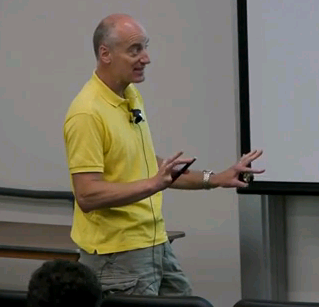UCI Chem 131C Thermodynamics and Chemical Dynamics (Spring 2012)
Lec 21. Thermodynamics and Chemical Dynamics -- The Steady State Approximation --
View the complete course: ../courses/chem_131c_thermodynamics_and_chemical_dynamics.html
Instructor: Reginald Penner, Ph.D.
License: Creative Commons BY-NC-SA
Terms of Use: ../info.
More courses at http://ocw.uci.edu
Description: In Chemistry 131C, students will study how to calculate macroscopic chemical properties of systems. This course will build on the microscopic understanding (Chemical Physics) to reinforce and expand your understanding of the basic thermo-chemistry concepts from General Chemistry (Physical Chemistry.) We then go on to study how chemical reaction rates are measured and calculated from molecular properties. Topics covered include: Energy, entropy, and the thermodynamic potentials; Chemical equilibrium; and Chemical kinetics. This video is part of a 27-lecture undergraduate-level course titled "Thermodynamics and Chemical Dynamics" taught at UC Irvine by Professor Reginald M. Penner.
Thermodynamics and Chemical Dynamics (Chem 131C) is part of OpenChem: ../openchem/
Recorded on May 21, 2012.
Index of Topics:
00:05 - some announcements...
02:37 - today...
03:36 - Svante Arrhenius
04:20 - Arrhenius discovered the greenhouse effect in 1896
04:39 - Article Arrhenius wrote about climate change
05:59 - experimentally we often observe an acceleration...Arrhenius Equation.
10:25 - consecutive reactions are sequences of reactions...
11:49 - an understanding of consecutive reactions is important...
12:44 - consider this generic consecutive reaction:
14:28 - what do these equations predict about [B] versus time?
18:02 - Ok, now let's look at the other possibility:
18:36 - what if...
20:23 - this suggests an expedient method for dealing with...steady-state approximation
25:50 - So - how does this compare with the exact solution?
27:08 - ...Let's first examine a case where we expect that it will work well...
28:40 - now we'll make...
29:16 - now a case where we expect...
30:32 - ...and this is a complete disaster - just as expected.
31:16 - the Steady-State Approximation:
33:43 - REMEMBER: this works if...
33:58 - Irvine Langmuir
35:00 - a page from G.N. Lewis's lab notebook...
35:26 - Photo: How does this work (tungsten bulb)?
37:35 - until 1906, all lightbulbs had carbon filaments. These bulbs were also evacuated
42:20 - the Lindeman-Hinshelwood mechanism...
48:18 - let's apply the steady-state approximation...
Required attribution: Penner, Reginald Thermodynamics and Chemical Dynamics 131C (UCI OpenCourseWare: University of California, Irvine), ../courses/chem_131c_thermodynamics_and_chemical_dynamics.html. [Access date]. License: Creative Commons Attribution-ShareAlike 3.0 United States License.



